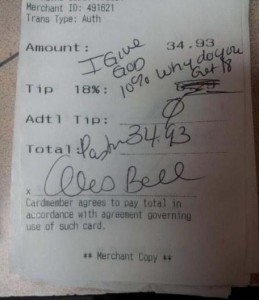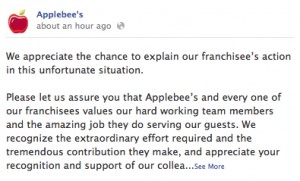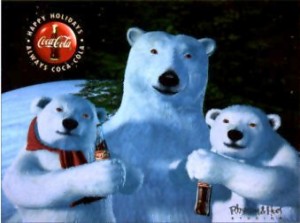When I came across Maddie Erjavec’s blog post about the impact of social media on brand marketing, I was surprised that a majority of the reviews written about companies were positive. Voluntary response channels, like social media, can be volatile as most users that comment on their experience with a brand will be the most strongly opinionated, whether that attitude be positive or negative. Perhaps the most dangerous part of social media as a tool for brand awareness is how uncontrollable it is, and how quickly it can spin out of the PR manager’s control, like was the case for Applebee’s recent Facebook meltdown. Public relations is often loosely defined as “spinning the story” to create positive publicity out of an unfavourable event, which Applebee’s attempted to  do in the wake of firing a waitress after she posted a picture of a receipt that a customer had left a snarky remark on, claiming that the waitress had violated the customer’s privacy. In a world where so much of our lives have become public property with the advances in technology and communication, Facebook users were outraged that the waitress was fired and began creating anti-Applebee’s boycotts and spamming the company’s Facebook page. In an attempt to appease the angry customers, whose comments were potentially causing them to lose a loyal consumer base, Applebee’s posted a status stating “We wish this situation didn’t happen…Our franchisee has apologized to the Guest and has taken disciplinary action with the Team Member for violating their Guest’s right to privacy.” This statement had exactly the opposite effect that Applebee’s PR team meant it to have, generating some
do in the wake of firing a waitress after she posted a picture of a receipt that a customer had left a snarky remark on, claiming that the waitress had violated the customer’s privacy. In a world where so much of our lives have become public property with the advances in technology and communication, Facebook users were outraged that the waitress was fired and began creating anti-Applebee’s boycotts and spamming the company’s Facebook page. In an attempt to appease the angry customers, whose comments were potentially causing them to lose a loyal consumer base, Applebee’s posted a status stating “We wish this situation didn’t happen…Our franchisee has apologized to the Guest and has taken disciplinary action with the Team Member for violating their Guest’s right to privacy.” This statement had exactly the opposite effect that Applebee’s PR team meant it to have, generating some  17,000 comments in less than 12 hours, at which point Applebee’s escalated the situation even further to began engaging with angry comments by tagging users and directly responding to their qualms. Although for getting brand recognition social media is effective, when opinions are uncensored and delivered in mass, companies like Applebee’s need to reshape their PR strategies to handle situations that can quickly spin out of control.
17,000 comments in less than 12 hours, at which point Applebee’s escalated the situation even further to began engaging with angry comments by tagging users and directly responding to their qualms. Although for getting brand recognition social media is effective, when opinions are uncensored and delivered in mass, companies like Applebee’s need to reshape their PR strategies to handle situations that can quickly spin out of control.
Monthly Archives: March 2013
Part II: Branding an Entire Species
When asked to conjure an image that represents a brand, our culture is likely to think of logos or trademarks that are recognizable by their presence on many of the brand’s products, not an entire species of animals. The same can’t be said for Coca Cola, who has managed to integrate polar bears into a vital part of their brand image and advertising campaigns across the globe. Recently winning the Brand Icon Award from the CLIO Awards, Coca Cola was recognized for leveraging innovative advertising techniques to increase their brand equity. Coca Cola has used their polar bear campaign, which has been part of print-advertising since 1922, to “epitomize the cheerful, heart-warming atmosphere that Coca Cola is hoping to bring” to their consumers.
Teaming with the World Wildlife Fund, Coca Cola has reduced greenhouse gas emissions themselves, as well as promoted sustainable living by educating North Americans on climate change solutions. This initiative, which has largely differentiated Coca Cola from their main competitor Pepsi, shows the company’s concern for the environment, and more specifically how climate change will negatively impact their mascot, the polar bear. As providers of a convenience product that consumers are largely price  sensitive towards, having a brand that advocates for the extremely relevant social issue of sustainable living and preventing climate change will allow Coca Cola to capture consumers that are not strictly loyal to a specific soft drink company. Not only does Coca Cola hope to capitalize on corporate social responsibility, but they also hope to appeal to the psychographic aspects of the consumers that fosters a visceral reaction by relating polar bears to a sense of family and love. And that being said, after the animated commercials directed by famed Ridley Scott, one of which depicts an adorable family of polar bears building a “snow bear” together, who can resist buying a Coca Cola product that has the very same polar bear on the can?
sensitive towards, having a brand that advocates for the extremely relevant social issue of sustainable living and preventing climate change will allow Coca Cola to capture consumers that are not strictly loyal to a specific soft drink company. Not only does Coca Cola hope to capitalize on corporate social responsibility, but they also hope to appeal to the psychographic aspects of the consumers that fosters a visceral reaction by relating polar bears to a sense of family and love. And that being said, after the animated commercials directed by famed Ridley Scott, one of which depicts an adorable family of polar bears building a “snow bear” together, who can resist buying a Coca Cola product that has the very same polar bear on the can?

